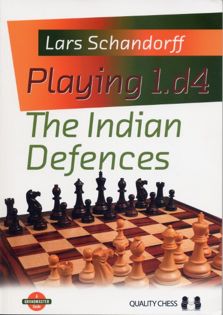Playing 1.d4 — The Indian Defences
Lars Schandorff

The second of a two-volume repertoire for White with 1.d4, this addresses all of blacks “Indian defenses against 1.d4 and 2.c4 (the first volume did an in-depth analysis of the Queens Gambit 1.d4 d5 2.c4). We get:
1) Nimzo-Indian
Follow the Patriarch
Various 4th Moves
The 4
…b6 Variation
The 4
…c5 Variation
The 4
0-0 Variation
The Mainline: 6
…Bd6
The Mainline: 6
…Be7
2) Kings Indian
Various 4th and 5th Moves
Various 6th Moves
Panno Variation
The New Panno Variation
The Old Mainline
The Samisch Gambit
3) Grunfeld Defense
Smyslov Variation
Prins Variation
Hungarian Variation
The Positional 8.Be2
Modern Mainline: 7
…Nc6
4) Modern Benoni
…a6 or
…Na6?
The
…a6-line
5) Benko Gambit
The 5
…axb5 Variation
The 5…
g6 Variation
The 5
…e6 Variation
6) Old Indian
The 5
…Nc5 Variation
The 5…
Be7 Variation
7) Dutch Defense
2
…c5
2
…d6
2…
c6
2…
d5
2
…Nf6
2
…h6
2…
c5
8) Minor Lines
A) Rare Moves
B) Various Benonis
C) The Budapest Gambit
D) 1
e6 Systems
E) The Modern Defense
Index of Main Games
Index of Variations
In my review of Schandorffs first volume on the Queens Gambit, I compared it to Watsons (all in one volume) A Strategic Chess Opening Repertoire for White. To quote a paragraph from that review:
Watsons book tends towards a safe, somewhat conservative repertoire so that new discoveries wont kill his recommendations (makes sense!). Schandorffs books are more cutting edge, which means that some (not many, but some) of his recommendations are bound to be refuted or made harmless as games are played and improvements (inevitable with sharp lines) are discovered. Both authors philosophies will please some and not others. Watsons book caters to players who are happy with sound, safe systems that dont strive for more than a small edge (if Black plays perfectly). Schandorff strives to grab a stronger, more theory oriented audience his work seeks to address the latest fashion and/or the most critical tests, knowing full well that some of his ideas will need adjustments as time progresses.
Schandorff continues that mainline trend in his second volume, recommending sharp, aggressive, theory-intensive lines. Though Watson and Schandorff usually go off in difference directions regarding the lines they recommend, I was a tad surprised to see both eschew the Queens Indian (1.d4 Nf6 2.c4 e6 3.Nf3), the Catalan (1.d4 Nf6 2.c4 e6 3.g3), and popular Nimzo-Indian lines like 1.d4 Nf6 2.c4 e6 3.Nc3 Bb4 4.Qc2. Instead they gave thumbs up to the strategically intense Rubinstein Variation of the Nimzo-Indian (1.d4 Nf6 2.c4 e6 3.Nc3 Bb4 4.e3), which has indeed made a big comeback in recent years. However, when we take a look at other Indian lines, the stylistic and philosophical differences between the authors was apparent.
Kings Indian Defense (1.d4 Nf6 2.c4 g6 3.Nc3 Bg7 4.e4 d6) and now:
Schandorff goes with the very sharp Samisch Variation (5.f3), giving it a literary fist-pump by saying, “The only side likely to be doing any attacking on the kingside is White.
Watson also goes for an aggressive approach, recommending 5.h3 which leaves Be3, Bg5 and even g4 on the table.
Grunfeld Defense (1.d4 Nf6 2.c4 g6 3.Nc3 d5) and now:
Schandorff goes for the very important, very rich, and very complicated Russian System (4.Nf3 Bg7 5.Qb3).
Watson is a fan of 4.cxd5 Nxd5 5.e4 Nxc3 6.bxc3 Bg7 and now he ignores all the theory-heavy main lines (7.Nf3, 7.Bc4, and 7.Be3) with two rare alternatives: 7.Bg5 and 7.Qa4+. Both of these lines strive to avoid theory and seek a small, safe edge. On the other hand, Schandorffs Russian System seeks to push an unprepared opponent right off the board, but more memorization and hard work is needed than Watsons idea-driven choices.
The Dutch Defense (1.d4 f5) further highlights the authors repertoire stances:
Schandorff avoids the main lines (2.c4 with g3) and instead goes for a very aggressive alternative via 2.Bg5. This often leads to some very violent play, and is a death sentence for Black if he isnt properly prepared to meet it.
Watson also avoids the main lines, but does so with the more positional 2.Nc3, which again calls for far less memorization (less risk and less work), but also accepts less quick crushes than 2.Bg5.
As with my review of Schandorffs first volume on the Queens Gambit, I would pick and choose lines from Watsons and Schandorffs books that were more to my taste (yes, there are many occasions where I would prefer a Schandorff line over a Watson line, and vice versa).
Schandorffs Playing 1.d4: The Indian Defences finishes off a superb two-volume repertoire for White. The Indian Defense and Queens Gambit are must-owns for players 2000 and above that open with 1.d4.
